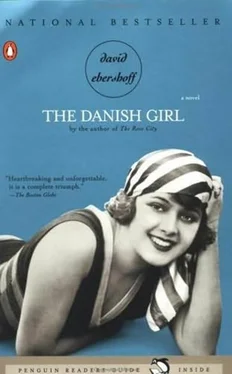“He had lost a lot of weight by then. He was quite weak. He must have been too frightened to eat. But he agreed to let me attempt it on him. He cried when I told him I could do it. He said he was crying because he felt like he was killing somebody. ‘Sacrificing somebody,’ that ’s what he said.
“I set the surgery for a Thursday morning. It was going to be in the large amphitheater; there were that many people who asked to come. A few doctors from the Pirna Clinic as well. I knew that if I succeeded I would have done something extraordinary, something no one had even dreamed of. Who could think it possible, going from man to woman? Who would risk his career to try something that sounds like something from a myth? Well, I would.”
Professor Bolk shook out his coat.
“But then early that Thursday morning, the nurse went to Sieglinde’s room and discovered that he was gone. He’d left his belongings, his felt hat, his pocket watch, his green dress, everything. But he was gone.” Professor Bolk drained his remaining coffee.
And Greta finished her lemonade, and Anna rose to call the maid ( “Les boissons,” in a snappy voice), and Greta studied the professor, his left knee angled over his right. This time she knew she was right; he was no Hexler. He understood. He was like her, she thought. He could see things, too. She wouldn’t have to think it over; her decision came like a clean blow to the head, with a pop of light at the back of her eyes. It made her start, jumping slightly in the settee, and Greta, who once in the south of France had nearly killed herself and Einar too by accidentally losing control of their motorcar and hurling it toward a cliff spotted with mimosas springing from the rocks, thought: I must take Lili to Dresden. She and I will have to go.

The next day, the girl behind the bureau located more books for Einar. Books called The Sexes ; The Normal and Abnormal Man ; A Scientific Study of Sexual Immorality ; and Die sexuelle Krise , published in Dresden twenty years earlier. Most were about theories of gender development based on hypothesis and casual experimentation on laboratory rats. In one Einar read about a man, a Bavarian aristocrat, who was born with both a penis and a vagina. There was something about his plight-the confusion as a child, the parental abandonment, his hopeless hunt for a place in the world-that made Einar close his eyes and think, Yes, I know. There was a chapter on the myth of Hermes and Aphrodite. The book explained sexual pathology, and something called sexual interme diacy. Somehow Einar knew he was reading about himself. He recognized the duality, the lack of complete identification with either sex. He read about the Bavarian, and a dull distant pang lay at rest in Einar’s chest.
Some of the books were old, from the last century, dust on their spines. Their pages turned with such a brisk crinkling noise that Einar feared the students would look up from their work on the long reading table and, from the twist of fear and relief in Einar’s face, learn who he really was.
Anne-Marie would place the books in front of Einar in a little tilted stand that held them at an angle. She lent him a string of lead beads wrapped in felt that held the page open while Einar copied sentences into his pewter-backed notebook.
The tables were wide and nicked, and they made Einar think of the worktables the Copenhagen fisherwomen used when chopping chub heads at the Gammel Strand fish market. In front of Einar, there was enough room on the table to fan out several books around him, and with their sand-colored pages open he began to think of them as his little shoal of protection. And that was how it felt to read them, during those mornings when he would slip out of the apartment: as if each sentence about the male and female would protect Einar over the next year, when everything, as he had promised himself, would change.
He eventually read enough to become convinced that he too possessed the female organs. Buried in the cavity of his body were Lili’s organs, the bloody packets and folds of flesh that made her who she was. At first it was hard to believe, but then the notion of it-that this wasn’t a mental problem, but a physical one-made more and more sense to him. He imagined a uterus shoved up behind his testicles. He imagined breasts somehow trapped by his ribcage.
Einar spent a week in the reading room, and there was a point each day when he would become so overwhelmed by what he was discovering that he ’d rest his head on his arms and softly cry.
If he nodded off, Anne-Marie, with her small white hand, would nudge Einar back to work. “It’s noon,” she’d say, and for a second he would become confused: Noon?
Oh, yes. Noon.
Carlisle had taken to asking Einar to join him in the afternoons. “Meet me at noon?” Carlisle would say each morning as Einar was slipping out the front door, nearly lost in a white heat of anticipation about what was waiting for him at the library.
“I’m not sure I can,” Einar would reply.
“But why not?” Greta would say.
Carlisle knew not to ask Greta to join them. He once told Einar that even when they were little, she would sigh with disappointment whenever Carlisle suggested they head down to the archery range in the Arroyo Seco. “She was always too busy to explore,” Carlisle would say. “Reading Dickens, writing poetry, painting scenes of the San Gabriels, painting pictures of me. But she never showed them to me. I’d ask to see one of her little watercolors and she would blush, and fold her arms against her chest.”
So Carlisle turned to Einar. He had to prod Einar at first. There was something about Carlisle ’s blue eyes, which were clearer than Greta’s, that seemed capable of reading Einar’s thoughts. He found it difficult to sit still next to Carlisle, shifting his weight from one hip to the other, sitting up and then retreating in the rope-bottom chair.
Carlisle bought a car, an Alfa Romeo Sport Spider. It was red with spoke-wheels and a running board with a red toolbox bolted to it. He liked to drive with the canvas top pushed back. The dash was black with six dials and a little silver handlebar that Einar would cling to as Carlisle shot around a corner. The floors were made of dimpled steel, and as Carlisle drove the Spider around Paris, Einar could feel the heat from the engine through the soles of his shoes.
“You should really learn to trust people more,” Carlisle said one day in the car, his hand moving chummily from the gear stick with its black-ball knob to Einar’s knee. He was driving Einar out to a tennis stadium in Auteuil. The stadium was next to the Bois de Boulogne, a concrete bowl rising up among the poplar trees. It was late morning, and the sun was high and blank in the blue-white sky. The flags around the rim of the stadium were hanging limply. There were iron gates around the tennis park, and men in green blazers and straw hats were taking tickets and ripping them in two.
A man led Einar and Carlisle to a little sloping box that was painted green. There were four wicker chairs in the box, each with a striped cushion. The box was at the baseline of the tennis court, which was made of crushed clay as red as the rouge Lili once purchased at the front counter of Fonnesbech’s.
On the court, two women were warming up. One was from Lyon; the sail of her long pleated skirt was white, and she cut across the court like a schooner. The other was an American, a girl from New York, the program reported; she was tall and dark, her hair as short and shiny as an aviator’s leather cap.
Читать дальше













